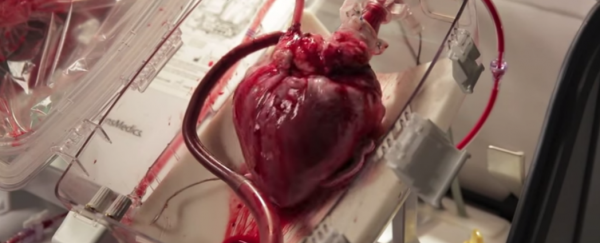Researchers in the US have developed a device that can bring a dead heart back to life, even after it's stopped beating inside its original body. And while this is great news for those in need of a heart transplant, it's already raising big ethical questions over how we can proclaim a person "dead" if we can restart their heart in someone else's body.
"How can you say it's irreversible, when the circulatory function is restored in a different body? We tend to overlook that because we want to transplant these organs," Robert Truog, a medical ethicist at Harvard University in the US, told Antonio Regalado at MIT Technology Review.
Right now, if you need a heart transplant, you're going to have to wait for the family of a vegetative patient to sign one over to you, because transplanting a heart from a deceased person is considered too risky. Hearts from vegetative patients, on the other hand, can be cooled down inside the body when the person is still alive, gently stopped, extracted, and transported in a container at around 4°C.
Cooling it down this much means the heart's metabolic activity will be cut by up to 90 percent, which gives doctors enough time to stitch it up inside someone else and get it beating again before it runs out of oxygen. About 180 hearts are made available for transplant in the US each year using this technique, but that's no where near meeting demand. "In the US about 2,400 heart transplants occur each year, a figure that has remained essentially unchanged for 20 years," Regalado reports.
Developed by Massachusetts-based company, Transmedics, the new heart-in-a-box device works by keeping the extracted heart warm, not cool. The heart is transferred to a sterile chamber fitted on a wheeled cart, inside which tubing is clamped onto the organ to give it a constant supply of oxygen, blood, and nutrients. The team behind the design says this will likely prolong the amount of time a heart can be kept functional outside a body.
"A human organ has never been kept alive outside of a human body until this machine became a clinical reality," Abbas Ardehali, the head of University of California, Los Angeles's heart and lung transplant program, told Chanelle Berlin Johnson from Al-Jazeera. "It makes intuitive sense to a layperson to say, 'Instead of having my heart on ice, I want it to be warm. I want it to be beating.'"
The downside? Well, apart from the price tag of US$250,000 a piece, the heart-in-a-box does raise questions over when 'dead is dead' if there's a possibility that a dead heart can be popped into the machine, restarted, and given back to the original owner. But for Harvard ethicist Robert Truog, the fact that the person has already died once is the key factor here, and it should be up to the families to decide what happens.
"My argument is that they are not dead, but also that it doesn't matter," Truog told Regalado. "They are dying and it's permissible to use their organs. The question is whether they are being harmed, and I would say they are not."
It's certainly an interesting question, and one we'll surely continue to face as the technology for reviving and preserving organs grows ever more sophisticated. We knew those undergrad philosophy classes would come in handy someday…
